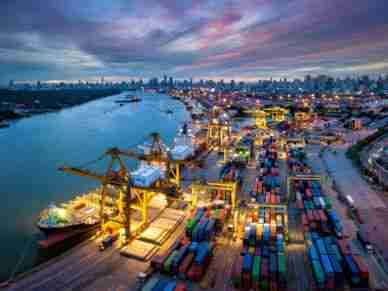Avoid These 3 Mistakes
Poor supply chain planning can result in delays, high costs, labor distribution issues, product shortages and more. However, people can minimize or eliminate those problems with better strategies. Knowing some common mistakes to avoid is an ideal way to keep operations running smoothly, even when obstacles arise.
1. Failing to Manage Workload Fluctuations
Seasonality, limited-time promotions or celebrity endorsements are some of the many things that can cause demand spikes for some supply chain products. Similarly, workloads can fall into brief lulls that may leave managers scrambling to keep up once the normal pace resumes. Such fluctuations created difficulties for a multinational consumer goods company, affecting multiple sites.
When leaders examined the issue, they found that workloads were generally lighter on weekends but spiked on Monday, Tuesday and Wednesday. This trend persisted at 10 major North American distribution centers. These facilities and the associated production plants handled up to 1,100 truckloads of products daily, illustrating the extent of the issue. Decision-makers chose to address it with a combination of process changes and technologies.
They discovered a severe lack of visibility in their end-to-end supply chains and understood that merely applying technology to existing processes would not solve the problem. Parties managing stock allocation and distribution had to make educated guesses and pull information from numerous systems, causing issues when workloads varied.
One of the solutions implemented was an artificial intelligence-enabled platform that automated distribution planning and deployment. The tool connected disparate systems and provided user recommendations to prevent future challenges restricting supply chain visibility. Ultimately, the process changes and technology improvements reduced daily variability by 40% and were particularly effective in locations where production plants ship items to distribution centers.
This case study illustrates the importance of pinpointing and examining problems to determine the best solutions. Workload fluctuations are typical in supply chains, so leaders should consider them inevitable to a certain extent. Tackling what is wrong will also pose challenges, but implementing strategies will have lasting benefits.
2. Providing Misleading Information to Stakeholders
Purchasers, retail partners, investors and others do not like hearing about likely product shortages, but sometimes being honest about them is essential for appropriately managing the situation. Shortages can lead to product stockouts, which affected parties should respond to as promptly as possible. An ideal solution is to improve demand-planning capabilities, making stockouts less likely.
Many people realize the items they want may sell out, which is more likely to happen during certain times of the year. One study found that 12% of Americans were very concerned about potential seasonal shortages. Many retailers have technology that automatically updates their websites once items are out of stock or running low. That information sets expectations for buyers, helping them determine if they should look for alternative products, wait for more items to arrive or purchase immediately while a few remain.
However, pressing problems can occur if companies give stakeholders information suggesting supply chain shortages are less severe than reality indicates. Sometimes, this wrong information happens due to poor supply chain planning, such as if those involved underestimate the time required to get more stock or when companies have inadequate supplier networks. In other instances, leaders purposefully give incorrect information to reduce people’s perception of persistent issues.
The latter case happened when representatives from an electric truck manufacturer expected to get more than 200 parts from a key supplier but miscalculated the ease and speed required for successful sourcing. Even worse, once those problems became apparent, the company assured investors there were no supply issues. These statements resulted in scrutiny from federal regulators. Being honest is always the best option, even when it means delivering disappointing news to those who believe in and trust the affected companies.
3. Lacking Knowledge of Changing Conditions
Economic conditions have created problems for people struggling with poor supply chain planning, making it harder for them to respond to developing situations. However, when professionals establish a practice of anticipating issues before they occur, it is easier to weigh the best strategies and implement them when necessary.
For example, statistics indicate that freight indexes in 2023 were nearly 10 times higher than before the COVID-19 pandemic. Inflation caused other price-related issues that forced supply chain managers to readjust their budgets and look for alternatives to keep costs down. However, when leaders are unaware of trouble brewing, problems may become severely disruptive before they realize there is no choice but to address them.
Digital twins and other simulation-based tools can help leaders determine the likely effects of specific changes. That knowledge can shape their future decisions and improve preparedness.
Additionally, once executives realize that industry trends have taken them by surprise, they may commit to making substantial changes to prevent future occurrences. That was the approach taken by leaders of a global telecommunications company that experienced extensive supply chain disruptions during the pandemic. Decision-makers knew it was time to establish better end-to-end supply chain resilience and chose two priorities while doing so.
First, they adopted a dual-production model that enabled using two different designs for the same products, providing more flexibility during future shortages. Additionally, company representatives evaluated each design’s research and development outlays and balanced them with lower inventory-holding costs.
A later pilot test of these two strategies helped participants evaluate the feasibility of applying this model to other products. More broadly, the changes increased flexibility and empowered the business to expand its supplier base if conditions demanded. However, understanding the industry’s multifaceted challenges was essential to this success.
Safeguarding Against Poor Supply Chain Planning
Poor supply chain planning can affect companies of all sizes and types, even when their employees follow numerous best practices. However, as these case studies illustrate, oversights can have far-reaching effects.
The best starting point is for leaders to examine past issues driven by insufficient preparation. Which primary factors worsened them? What are the best prevention strategies, and can the company implement them now? Asking such questions and adopting new methods can allow people to respond swiftly and effectively to challenges on the horizon.
Emily Newton is the Editor-in-Chief of Revolutionized Magazine, an online publication that explores innovations in science and technology.














Leave a Reply